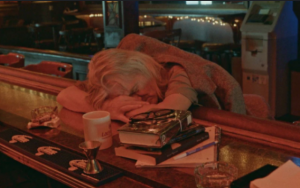BLOODY NOSE, EMPTY POCKETS: 4 STARS. “experimental combo of documentary and fiction.”
 A truly great bar doesn’t just dispense drinks. Forget about bottle service and VIP booths, a great bar specializes in good will, community and acceptance for all who enter their doors. That’s the case with the Roaring ’20s, the dive bar that serves as the backdrop for “Bloody Nose, Empty Pockets,” a new hybrid documentary that comes to virtual cinemas this week.
A truly great bar doesn’t just dispense drinks. Forget about bottle service and VIP booths, a great bar specializes in good will, community and acceptance for all who enter their doors. That’s the case with the Roaring ’20s, the dive bar that serves as the backdrop for “Bloody Nose, Empty Pockets,” a new hybrid documentary that comes to virtual cinemas this week.
It’s last call at Roaring Twenties, a threadbare bar way off the strip in Las Vegas. It’s the kind of place where the bartender says, “The best part of waking up is bourbon in your cup,” as he spikes a customer’s coffee with a shot.
Set to close forever on the eve of the 2016 election, it’s populated by regulars like former actor Michael, who declares, “I prised myself on not having become an alcoholic until after I was already a failure. Alcoholic failures are the worst.” He’s joined by a loud drunk who occasionally flashes her breasts at the bar, a veteran with a thousand-yard stare and Lowell, a good-natured free spirit. Others come and go, like John, the Australian who brings a box of donuts for everyone and downs beer after beer before dropping acid and heading out for a night of tripping.
Others come and go, fights brew, tears are spilled and Michael philosophizes about a life spent staring at the bottom of a shot glass. “There is nothing more boring than a guy who used to do stuff,” he says, “but doesn’t do stuff anymore because he’s in a bar.” He emerges as the central character, someone who essentially lives at the bar—he often sleeps on the overstuffed couch in the back, and will become homeless when they put the lock on the door for the final time.
“Blood Nose, Empty Pockets” isn’t story driven as much as it is a portrait of a time and place. But it’s also not a documentary in the strictest sense. Directors Bill and Turner Ross shoot cinéma verité (“truthful cinema”) style but the story is a bit of a fib. The bar is actually located in New Orleans and is still open. The regulars are folks recruited from local bars brought together to participate in a preplanned story arc. That’s not to say here weren’t surprises. John’s acid trip was impromptu as was a scene featuring a pair of veterans who shed tears remembering fallen friends.
Like a Cassavetes film, “Bloody Nose, Empty Pockets” is an experimental combination of documentary and fiction that favours characters and a sense of place over traditional story-telling. It’s rough and tumble, like the people it portrays. The rough-hewn sound and the hand held camera work creates the feel of having been sitting at the bar from morning to night. Conversations overlap, the images blur as a growing sense of melancholy settles over the film in its closing minutes.
Real or not, what “Bloody Nose, Empty Pockets” does best is show the community that exists at the Roaring 20s bar. The regulars have a bond, brought together by booze and friendship, that allows them to overlook one another’s personality peccadillos. It’s a community that looks after one another, where support means stopping a fight or having a too-close conversation with someone you just met. No bottle service, just barstool prophets and some plain, unvarnished truth. Even if the story is a set-up.
